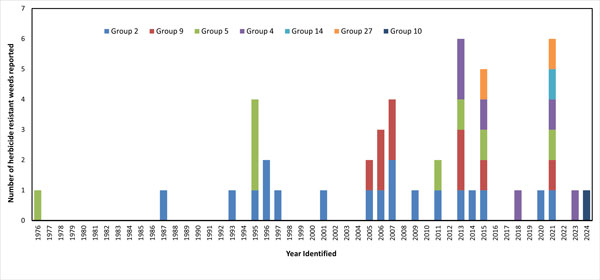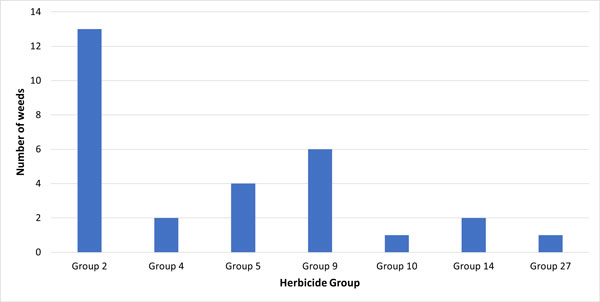This year marks the 50th anniversary of the first documented case of herbicide resistance in Kansas. In this article, we’ll look back on where we have been, where we are now, and what needs to be done in the future to combat this problem.
Understanding herbicide resistance
Herbicide resistance is defined as the ability of a weed population to survive an herbicide application that would normally kill that particular weed species. By contrast, herbicide tolerance is the natural ability of a weed species to grow and reproduce after treatment with a particular herbicide; that is, the weed was never very susceptible to that herbicide to begin with. The development of herbicide resistance is a process of selecting for naturally occurring genetic variation(s) that allow a plant to survive the herbicide application. Resistance can be broken down into two categories:
- Target Site Resistance (TSR). With TSR, a mutation in the resistant weed causes a change in the enzyme that the herbicide acts upon (the target site). Often, this is the result of a change in just one gene. In many cases, the change prevents the herbicide from binding at the site of action, but in some cases, it can be the result of an increase in the amount of enzymes present in the plant.
- Non-Target Site Resistance (NTSR). NTSR typically involves multiple genes, making it more challenging to control these weeds. In NTSR, the affected genes alter the herbicides’ translocation (the herbicide is not moved to the target site), sequestration (the herbicide is stored away from the target site), or metabolism (the herbicide is changed into nontoxic compounds prior to reaching the target site). Changes in metabolism, or metabolic resistance, are more common than other kinds of NTSR and are especially troubling. Metabolic resistance was discussed in a previous article.
First resistant weed in Kansas: Kochia
In 1976, kochia populations from railroad rights-of-way in Kansas were identified that were resistant to the Group 5 herbicide atrazine (Tables 1 and 2). The extensive use of atrazine likely led to this development. Resistance spread due to the tumbling nature of the weed and the extensive use of triazine herbicides in corn and sorghum fields. Today, triazine-resistant kochia is found throughout the entire state.
It took 11 years before another resistance case was confirmed, also in kochia (Figure 1). In 1987, a kochia population from Seward County was identified with resistance to the Group 2 (ALS-inhibiting) herbicide chlorsulfuron. Many Group 2 herbicides were being discovered and marketed during the 1980s, and were used extensively, especially in wheat and soybean fields. Since that time, kochia has developed resistance to two other commonly used herbicide groups in Kansas, including the synthetic auxin herbicides dicamba and fluroxypyr (Group 4) and glyphosate (Group 9).
Table 1. Herbicide groups with confirmed resistance in Kansas.
|
Herbicide group |
Site of action |
Examples |
|
2 |
ALS Inhibitors |
Imazamox, chlorsulfuron, nicosulfuron, metsulfuron |
|
4 |
Synthetic Auxins |
2,4-D, dicamba, fluroxypyr |
|
5 |
Photosystem II Inhibitors |
Atrazine, metribuzin |
|
9 |
EPSP Synthase Inhibitor |
Glyphosate |
|
10 |
Glutamine Synthase Inhibitors |
Glufosinate |
|
14 |
PPO Inhibitors |
Lactofen, acifluorfen, saflufenacil, flumioxazin |
|
27 |
HPPD Inhibitors |
Mesotrione, topramezone, tembotrione |
Table 2. Weed species with herbicide resistance in Kansas as of 2025, and the year first identified.
|
Weed species |
Herbicide groups |
||||||
|
Group 2 |
Group 4 |
Group 5 |
Group 9 |
Group 10 |
Group 14 |
Group 27 |
|
|
Bushy wallflower |
2005 |
|
|
|
|
|
|
|
Cheat |
2007 |
|
|
|
|
|
|
|
Common cocklebur |
1997 |
|
|
|
|
|
|
|
Common ragweed |
|
|
|
2007 |
|
|
|
|
Common sunflower |
1996 |
|
|
|
|
|
|
|
Flixweed |
2006 |
|
|
|
|
|
|
|
Giant ragweed |
|
|
|
2006 |
|
|
|
|
Henbit |
2014 |
|
|
|
|
|
|
|
Horseweed/ |
2011 |
|
|
2005 |
|
|
|
|
Japanese brome |
2007 |
|
|
|
|
|
|
|
Kochia |
1987 |
2013 |
1976 |
2007 |
|
|
|
|
Palmer amaranth |
1993 |
2015 |
1995 |
|
2021 |
2009 |
|
|
Redroot pigweed |
|
|
1995 |
|
|
|
|
|
Shattercane |
1996 |
|
|
|
|
|
|
|
Waterhemp |
1995 |
|
1995 |
2006 |
2024 |
2001 |
|
|
Wild buckwheat |
2020 |
|
|
|
|
|
|

Figure 1. Number of herbicide-resistant weeds confirmed by year over the past 50 years. The different colors represent resistance to a specific herbicide group. Graph created by Yasir Parrey, Kansas State Univ.
Pigweeds: Palmer amaranth and waterhemp
The next weed to develop herbicide resistance chronologically is perhaps the worst so far. In 1993, several Palmer amaranth populations were identified that were not controlled by imazethapyr. Imazethapyr is a Group 2 herbicide commonly used in soybean, alfalfa, and (at that time) herbicide-tolerant corn.
Palmer amaranth is a large, competitive weed in which each plant is either male or female (dioecious). When seeds are formed, pollen (and genes) are transferred from one plant to another. This mixing of genetic material has led to the increased spread of herbicide-resistant plants across the state. Palmer amaranth has also been shown to develop both TSR and NTSR, discussed earlier. The presence of NTSR has been linked to cross-resistance between different herbicide groups. Because of this, a plant that has resistance to one group (for example, Group 2) may also be resistant to other groups (such as Group 4) even without herbicide applications that would select for resistance to Group 4 herbicides. As a result, switching to a different herbicide class may not be sufficient to control these populations.
In 2021, a Palmer amaranth population was identified that was resistant to six of the herbicide groups listed in Table 1. Palmer amaranth is the only species in Kansas to have developed resistance to the HPPD-inhibiting herbicides mesotrione (Callisto) and isoxaflutole (Balance) (Group 27). Furthermore, Palmer amaranth with resistance to S-metolachlor (a Group 15 herbicide), has been documented as close as Arkansas and may well spread to Kansas in the near future if it hasn’t already. More recently, a Palmer amaranth population was found resistant to dicamba (a Group 4 herbicide), representing the first confirmed case for dicamba in this species.
Waterhemp, a pigweed species closely related to Palmer amaranth, is the only other species with resistance to more than two herbicide families (Table 2). In 1995, a Kansas population of waterhemp was not controlled by imazethapyr and thifensulfuron (both Group 2), while a separate population showed resistance to atrazine (Group 5). In 2006, glyphosate-resistant waterhemp was identified in Kansas. Like Palmer amaranth, waterhemp is dioecious, and resistance can spread rapidly. Waterhemp and Palmer amaranth are currently the only species in Kansas with resistance to the PPO inhibitors (Group 14). Currently, waterhemp is most commonly found east of the Flint Hills.
Other resistant weeds
In total, 16 species have been confirmed to have herbicide resistance in Kansas (Table 2). Of those, 13 are broadleaf species and three are grasses. All are annual species, though bushy wallflower, cheat, flixweed, henbit, horseweed (marestail), Japanese brome, and wild buckwheat often emerge in the fall and overwinter to cause problems in the next growing season. The greatest number of resistant species (13) have been confirmed for Group 2 herbicides, followed by Group 9 (glyphosate) with six (Figure 2). The peak years for the identification of new resistance cases were 2013 and 2021, with 6 cases each; however, only two new cases have been documented since 2021.

Figure 2. The number of herbicide-resistant weed species in Kansas by herbicide group. Graph created by Patrick Geier, Kansas State Univ.
Take Home Message
Herbicide resistance in Kansas has evolved over five decades, from a single case in kochia to multiple weed species resistant to several herbicide groups. Resistance is a naturally occurring phenomenon, but its spread is accelerated by repeated use of similar herbicides and limited diversity in control practices. The most effective way to manage resistant weeds and prevent new cases is to diversify control tactics through integrated weed management. Stay tuned for a second article that discusses integrated weed management practices and how to identify herbicide resistance in the field.
Reference
Heap, I. 2025. The International Herbicide-Resistant Weed Database. www.weedscience.org
For additional information, see the 2025 Chemical Weed Control for Field Crops, Pastures, and Noncropland or check with your local K-State Research and Extension office for a paper copy. https://bookstore.ksre.ksu.edu/item/2025-chemical-weed-control-for-field-crops-pastures-rangeland-and-noncropland_SRP1190
The use of trade names is for clarity to readers and does not imply endorsement of a particular product, nor does exclusion imply non-approval. Always consult the herbicide label for the most current use requirements.
Patrick Geier, Weed Scientist, Garden City
pgeier@ksu.edu
Yasir Parrey, Assistant Scientist, Weed Extension Lab
yasir1@ksu.edu
Sarah Lancaster, Extension Weed Management Specialist
slancaster@ksu.edu
Tags: herbicide resistance